The Astrophysical Institute of Potsdam (AIP) inaugurated the robotic telescopes STELLA I and II (STELLar Activity) on Tenerife island on May 18, 2006. STELLA is an observatory with two 1.2m telescopes which work autonomously by means of artificial intelligence. Not only are the telescopes automated, but also the entire observatory operates like a robot, and no longer requires any human presence. The data obtained are delivered to the Media and Communication Center of the AIP in Potsdam at the end of each night.
Initiated in 1998, today's STELLA observatory on the Izaña mountain on Tenerife is a collaboration of the Astrophysical Institute of Potsdam and the Instituto de Astrofísica de Canarias (IAC). The Principal Investigator of the project, Professor Klaus G. Strassmeier, joined the AIP with his robotics team from Vienna in 2000 and dedicated much of his effort to the STELLA project. Dr. Thomas Granzer programmed the robotic components of the telescope, Dr. Michael Weber works as the Project Manager of STELLA, together with the IAC on Tenerife, and Manfred Woche designed the optics of STELLA.
Eight years of hard work led to the first spectrum taken by STELLA I from a calibration light source on June 28, 2005. The first stellar spectrum followed on September 9, 2005, taken from the star α Tauri (K5 III). In April 2006, STELLA I started its robotic operation. Several problems had to be solved on the way to a functioning observatory. The building was, for example, occupied by worms which couldn't find their way out anymore and passed away in the observatory. While the worms are now kept off the building, the guests invited for the inauguration of the two telescopes gathered on top of the mountain at an elevation of 2400 m. Frequent storms posed another problem to STELLA and damaged part of the building in the past. An elaborate control system solves the problem today. Sensors distributed over the entire building report on the current environmental conditions of the telescopes, the scientific instruments, and the status of several secondary systems. The STELLA control system (SCS) predicts critical weather conditions such as humidity five minutes ahead and closes the roof in case of an upcoming storm.
|
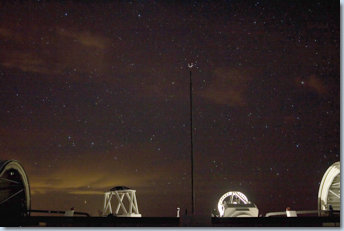
STELLA at night.
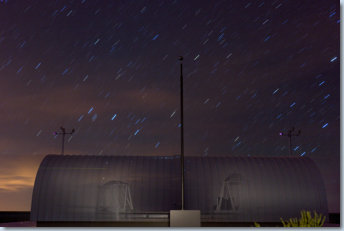
STELLA transparent: the photo was taken while the roof of the observatory was being closed.
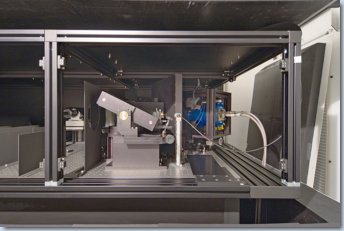
Fiber feeding the STELLA light into the echelle spectrograph.
|
Photos: [general] [technical] [inauguration]
[press release in German]
[STELLA home page]
[AIP home page]
|
|
|
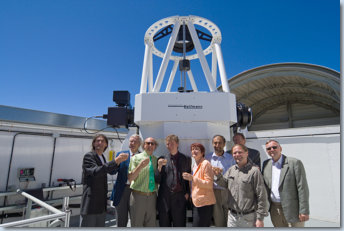
Cheers on the STELLA telescopes (all photos by R. Arlt).
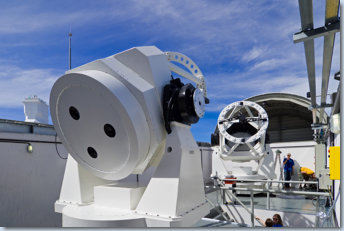
STELLA telescopes with open roof.
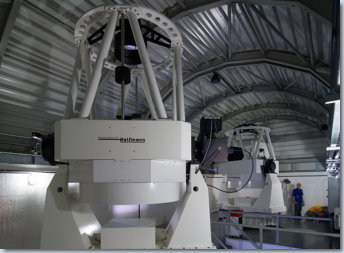
STELLA telescopes with closed roof.
|
The scientific goal of STELLA is the identification of stars similar to our Sun, as well as the discovery of terrestrial planets. The robotic operation of STELLA is ideally suited for the search for extrasolar planets by a method based on the light variation of the star when a planet transits in front of the stellar disk. A huge number of very precise measurements are necessary for the detection of the short-lived transit event. Such a task of diligence is taken over by a robot. Professor Strassmeier explains: "The combination of high-precision wide-field photometry with high-resolution spectroscopy is unique in the world. The two telescopes can observe the same object simultaneously and deliver a spectrum with radial velocities as well as a high-resolution image." STELLA has an automated data reduction pipeline (ASPEX) which provides the radial velocity, the rotational velocity, the surface temperature, the gravity, and the chemical composition for each spectrum of the star. Some of them are indicators of the magnetic activity of the stars. The high resolution of the spectra even allows the mapping of the surface of rapidly rotating stars.
The robotic operation of the telescopes implies very high flexibility and a large volume of data. The control software sets up its own observing schedule from a list of objects. The observatory and the weather-station work entirely autonomously and send the observing data directly to Potsdam. The STELLA building is observed by a web camera. The images can be viewed over the Internet. There is even a direct way for pupils to do astronomy with a robotic telescope at the AIP: RoboTel is an 80-cm version of the STELLA telescopes and is used for tests and educational purposes. The pupils can operate telescopes from the Media and Communication Center and watch the strategies of the artificial intelligence of STELLA I and II.
Press contact
Ms Shehan Bonatz
Astrophysikalisches Institut Potsdam
An der Sternwarte 16
D-14482 Potsdam
(0331) 7499 469

PI and Director at the AIP
Prof. Klaus G. Strassmeier
(0331) 7499 295

|


 last change 2006 May 26, R. Arlt
last change 2006 May 26, R. Arlt


